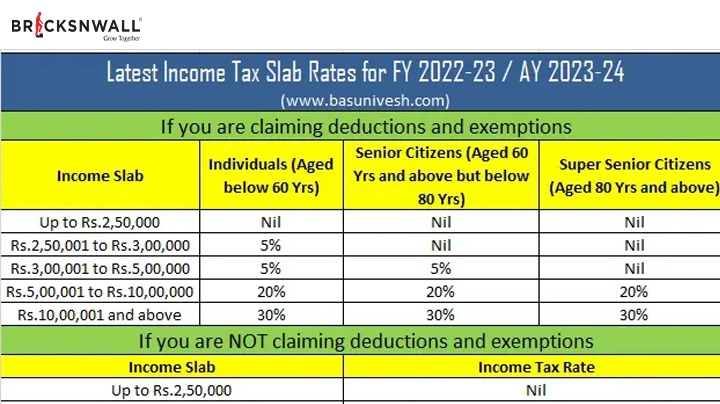New Income Tax Rates and Slabs
Bricksnwall Trusted Experts

In Budget 2023, Finance Minister Nirmala Sitharaman
made revisions to the income tax slab rates under the new tax system.
The alterations to the new tax structure that have
been announced for the fiscal year 2023–2024, which starts on April 1, 2023,
are as follows: The new revenue regime requires, the minimum exemption amount
to be increased from Rs 2.5 lakh to Rs 3 lakh. The new tax system becomes
taxpayers' default choice.
However, they do have the choice to stick with the
previous tax system. The new tax system has changed the income tax slabs. Under
the new tax system, a standard deduction of Rs 50,000 was made available to
salaried individuals and pensioners. For taxable incomes up to Rs 7 lakh, the
Section 87A rebate rose under the new tax system. If individuals choose the new
tax system in FY 2023–24, they will not be required to pay any taxes if their
taxable income is less than Rs 7 lakh. The highest surcharge rate was decreased
under the new tax system from 37% to 25%.
For FY 2023–2024, the income tax bracket and rates
under the previous tax system stay the same. The deductions and exemptions that
were permitted under the previous tax system remain unchanged as well. If
taxable income does not exceed Rs 5 lakh, a rebate under Section 87A is
available under the previous tax system.
Income tax rates under the new tax system for FY
2023–24 (AY 2024–25)
In the new tax system, modifications to the income
tax slabs have been announced in Budget 2023. The income tax slabs have been
altered to improve the appeal to individual taxpayers. The basic exemption
threshold was increased by the budget from Rs 2.5 lakh to Rs 3 lakh.
The new tax system's income tax brackets are listed
below.
Income tax rates under the new tax law for the
years 2023–2024
|
Income
tax slabs (Rs) |
Income
tax rate (%) |
|
From
0 to 3,00,000 |
0 |
|
From
3,00,001 to 6,00,000 |
5 |
|
From
6,00,001 to 9,00,000 |
10 |
|
From
9,00,001 to 12,00,000 |
15 |
|
From
12,00,001 to 15,00,000 |
20 |
|
From
15,00,001 and above |
30 |
announced adjustments to the new tax code for FY
2023–24
The modifications made to the new tax system to
make it more appealing are listed below:
The new income tax system takes over as the default tax system. Therefore, income will be taxed at the new tax regime's slabs and rates unless a person specifically chooses the old tax system. The Section 87A tax credit amount has increased from Rs. 5 lakh (or Rs. 12,500 in tax credits) to Rs. In fact, this means that those who choose the new tax system and have taxable income up to Rs. 7 lakh will not be required to pay any taxes.
Previously, this tax credit was offered up to a taxable income of Rs 5 lakh. In the new tax system, the basic exemption ceiling was increased from Rs 2.5 lakh to Rs 3 lakh.
There are now only five income tax brackets under the new tax code, down from six. Under the new tax law, a standard deduction of Rs. 50,000 has been made available to salaried individuals and pensioners. Under the new tax law, family pensioners can also claim a standard deduction of Rs.
Under the new tax law, the highest surcharge rate,
previously 37%, has been lowered to 25%.
The new tax system's income tax brackets are in
effect through FY 2022–23 (AY 2023–24).
The income tax slabs under the new tax regime are different from those previously indicated for FY 2022–23 (ending on March 31, 2023) and before.
|
Income
tax slabs in new tax regime till FY 2022-23 |
|
|
Income
tax slabs (Rs) |
Income
tax rate (%) |
|
From
0 to 2,50,000 |
0 |
|
From
2,50,001 to 5,00,000 |
5 |
|
From
5,00,001 to 7,50,000 |
10 |
|
From
7,50,001 to 10,00,000 |
15 |
|
From
10,00,001 to 12,50,000 |
20 |
|
From
12,50,001 to 15,00,000 |
25 |
|
From
15,00,001 and above |
30 |
How to compute the income tax due under the new tax
system
Here is how to determine the amount of income tax
due if you have chosen the new tax structure for the current fiscal year, or FY
2022–23.
Be advised that under the current tax code, only
expenses listed in section 80CCD (2) of the Income-tax Act of 1961 may be
written off. No additional exemptions or deductions are permitted under the new
tax code.
Here is an example of how the new tax system may compute income tax.
Assume that a person would earn Rs 20 lakh in gross
yearly income in FY 2022–2023. Additionally, the company has deposited Rs. 1.5
lakh into the customer's Tier-I NPS account.
He can therefore claim a deduction as a
result under Income-tax Act section 80CCD(2)
How to determine net taxable income under the new
tax system
|
Particulars |
Amount
(In Rs) |
|
Gross
total income |
20,00,000 |
|
Deduction
under section 80CCD (2) |
1,50,000 |
|
Net
taxable income |
18,50,000 |
Therefore, after subtracting Rs 1.5 lakh from Rs 20
lakh, the net taxable income that would be used to determine the amount of
income tax due is Rs 18.50 lakh.
Up to Rs 2,50,000 of income are free from taxation
under the new income tax system. Therefore, there won't be any tax due on this
revenue. After this, there is a balance of Rs 16,00,000 in income that is still
subject to tax (Rs 18,50,000 minus Rs 2,50,000).
The following slab is from Rs 2.5 lakh to Rs 5
lakh. This means that 5% of the sum of Rs 16,00,000 will be taxed, or Rs 2.5
lakh (Rs 5 lakh minus Rs 2.5 lakh). Here, Rs 12,500 in tax will be due.
After this, there is a balance of Rs 13,50,000 in
income that is still subject to tax (Rs 16,00,000 minus Rs 2,50,000). The
following bracket ranges from Rs. 5 lakh to Rs. 7.5 lakh. The subsequent Rs 2.5
lakh (Rs 7.5 lakh minus Rs 5 lakh) from Rs 13,50,000 will be subject to 10%
tax. The amount of income tax due is calculated to be Rs 25,000.
(Rs 13,50,000 minus Rs 2,50,000) The remaining
revenue is Rs 11,00,000. The following income tax bracket ranges from Rs 7.5
lakh to Rs 10 lakh. As a result, 15% tax will be applied to the Rs 2.5 lakh (Rs
10 lakh less Rs 7.5 lakh) of Rs 11,00,000. The tax obligation will be for Rs.
37,500.
The remaining income that is still subject to tax
is worth Rs. 8,50,000 (or Rs. 11,00,000 less Rs. 2.5 lakh). The following
bracket ranges from Rs. 10 lakh to Rs. 12,50,000. The following Rs 2,50,000 out
of Rs 8,50,000 will be subject to Rs 20% tax. The amount of tax due is Rs.
50,000.
(Rs 8,50,000 minus Rs 2,50,000) The remaining
income that is still subject to tax is Rs 6,00,000. Between Rs. 12,50,000 and
Rs. 15,00,000 is the following slab. The subsequent Rs 2,50,000 (Rs 15,00,000
minus Rs 12,50,000) from Rs 6,00,000 will be subject to a 25% tax. The tax
obligation will be for Rs. 62,500.
Currently, the remaining revenue is Rs 3,50,000 (Rs 6,00,000 minus Rs 2,50,000). This will be subject to taxation at the 30% rate for the last tax bracket, or above Rs 15,00,000. The amount of tax due is Rs. 105,000.
|
Calculation
of income tax payable for taxable income of Rs 18.50 lakh |
||
|
Particulars |
Income
(Rs) |
Tax
amount (Rs) |
|
Net
taxable income |
18,50,000 |
- |
|
Income
exempt up to Rs 2,50,000 |
(2,50,000) |
0 |
|
Income
which is still chargeable to tax (Rs 18,50,000 - 2,50,000) |
16,00,000 |
- |
|
Income
tax slab of Rs 2.5 lakh and up to Rs 5 lakh |
(2,50,000) |
@
5% =12,500 |
|
Income
which is still chargeable to tax (Rs 16,00,000 - 2,50,000) |
13,50,000 |
- |
|
Income
tax slab of Rs 5 lakh up to Rs 7.5 lakh |
(2,50,000) |
@
10% = 25,000 |
|
Income
which is still chargeable to tax (Rs 13,50,000 -2,50,000) |
11,00,000 |
- |
|
Income
tax slab of Rs 7.5 lakh up to Rs 10 lakh |
(2,50,000) |
@15%
= 37,500 |
|
Income
which is still chargeable to tax (Rs 11,00,000 -2,50,000) |
8,50,000 |
- |
|
Income
tax slab of Rs 10 lakh up to Rs 12.50 lakh |
(2,50,000) |
@
20% = 50,000 |
|
Income
which is still chargeable to tax (Rs 8,50,000 -2,50,000) |
6,00,000 |
- |
|
Income
tax slab of Rs 12.50 lakh up to Rs 15 lakh |
(2,50,000) |
@25%
= 62,500 |
|
Income
which is still chargeable to tax (Rs 6,00,000-2,50,000) |
3,50,000 |
- |
|
Income
tax slab of above Rs 15 lakh |
(3,50,000) |
@30%
= 1,05,000 |
|
Total
income tax liability |
- |
2,92,500 |
|
Cess
at 4% on total income tax payable (i.e. on Rs 2,92,500) |
- |
11,700 |
|
Final
income tax liability (inclusive of cess) |
- |
3,04,200 |




